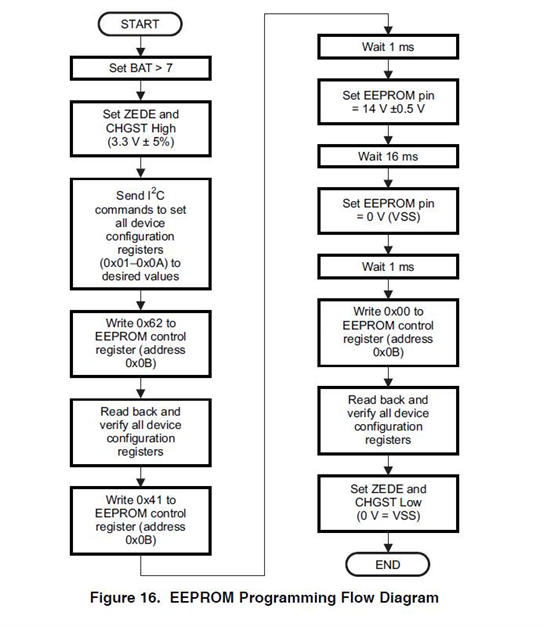Hi,
We are using BQ77910 for Protection in one of our projects.
My main query is related to programming/writing the data to EEPROM from the microcontroller.
I followed this flowchart and wrote the code exactly as the flowchart below.
In the below Flowchart, We are reading the data registers for verification 2 times, When i read for the first time i am getting all 10 Bytes of data (with only FIRST Byte missing).
in the second Verification (reading data) I get all random data.
If i reset and read the data, its all 0xFF
The following is the code i am using:
int main(void)
{
unsigned char UC_NumberOfCells = 0;
SysCtlClockSet(SYSCTL_SYSDIV_1 | SYSCTL_USE_OSC | SYSCTL_OSC_MAIN | SYSCTL_XTAL_8MHZ);
// ------------------------------------------------------------------------------------- Fz_Debug
#ifdef DEBUG_MODE
//ucDCard = MODBUS_DCARD_M; // for testing ModBus
ucDCard = I2C_DCARD_M; // for testing I2c
//ucDCard = UART_DCARD_M; // for testing UART
#endif // End of Debug Mode
// ------------------------------------------------------------------------------------- Fz_Debug
// Initialises the Communication Protocols
Init_Cards();
ChangeSOCI2CSpeed(50000); // 50KHz - SOCI2C
//-------------------------------------BQ77910 Testing--------------------------------------
char i, BQtest[10] = {0},BQtest2[10] = {0};
// CHGST and ZEDE Pins on the BQ77910 Need to be HIGH to Write/Read from the IC
// Enable Ports
SysCtlPeripheralEnable(SYSCTL_PERIPH_GPIOB);
GPIOPinTypeGPIOOutput(GPIO_PORTB_BASE, GPIO_PIN_5 ); // Configure CHGST PIN as O/P
SysCtlPeripheralEnable(SYSCTL_PERIPH_GPIOE);
GPIOPinTypeGPIOOutput(GPIO_PORTE_BASE,GPIO_PIN_3 ); // Configure ZEDE_EN PIN as O/P
SysCtlPeripheralEnable(SYSCTL_PERIPH_GPIOA);
GPIOPinTypeGPIOOutput(GPIO_PORTA_BASE, EEPROM_W_EN ); // Configure EEPROM_W_EN PIN as O/P
//Set ZEDE and CHGST High (3.3 V ± 5%)
CHGST_ENABLE_M; // Enable CHGST PIN
ZEDE_ENABLE_M; // ENABLE ZEDE_EN
while (1)
{
for (i = 1; i < 0x0B; i++) // Fz !Fz_Mod : z starts from 1
{
//Send I2C commands to set all device configuration registers (0x01–0x0A) to desired values
Write_SOCI2C_Byte(BQ77910A_ADDRESS, i, bq77910a_data[i-1]); // Fz
//Wait 10mS
Delay_ms(10); // Fz
}
// Write 0x62 to EEPROM control register (address 0x0B)
Write_SOCI2C_Byte(BQ77910A_ADDRESS, 0x0B,0x62);
Delay_ms(10);
// Read back and verify all device configuration registers
for (i = 1; i < 0x0B; i++)
{
BQtest[i - 1] = Read_SOCI2C_Byte(BQ77910A_ADDRESS, i);
Delay_ms(10);
}
// Write 0x41 to EEPROM control register (address 0x0B)
Write_SOCI2C_Byte(BQ77910A_ADDRESS, 0x0B,0x41);
//Wait 1 ms
Delay_ms(1);
//Set EEPROM pin HIGH
EEPROM_W_ENABLE_M;
//Wait 16 ms
Delay_ms(16);
//Set EEPROM pin HIGH
EEPROM_W_DISABLE_M;
//Wait 1 ms
Delay_ms(1);
//Write 0x00 to EEPROM control register (address 0x0B)
Write_SOCI2C_Byte(BQ77910A_ADDRESS, 0x0B,0x00);
// Read back and verify all device configuration registers
for (i = 1; i < 0x0B; i++)
{
BQtest2[i - 1] = Read_SOCI2C_Byte(BQ77910A_ADDRESS, i);
Delay_ms(10);
}
//Set ZEDE and CHGST LOW
CHGST_DISABLE_M; // Disable CHGST PIN
ZEDE_DISABLE_M; // Disable ZEDE_EN
}
}


